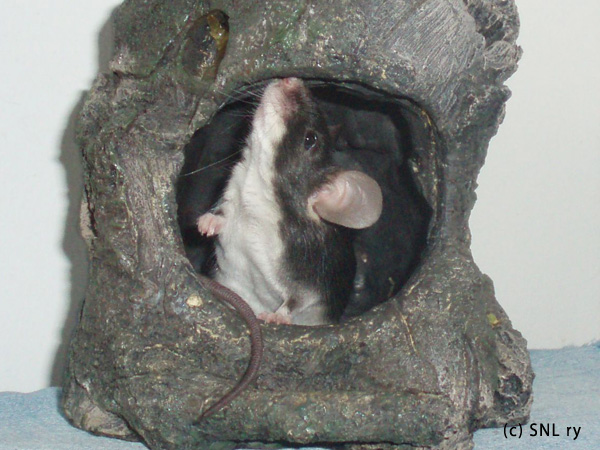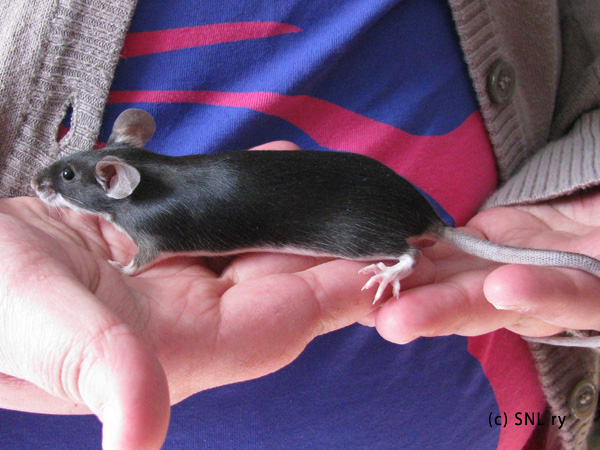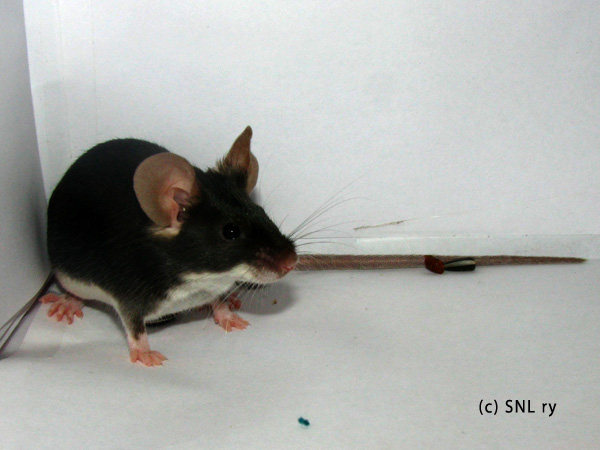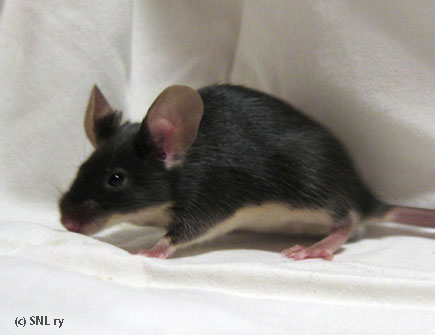Varieties
Foxes
V - Black Fox (ba/f)
at/* B/* cch/cch D/* P/*
"Eyes black. The colour should be dense, lustrous black. Feet, sides and rump only to be ticked with white hairs. Belly white."
Breeding information below the pictures.
Quick Look
Black fox is genetically a black tan with two chinchilla genes. The tan belly colour is diluted to white while the top colour is retained as black as possible. White ticking on the sides is desired. Because the chinchilla gene also dilutes black pigment to some degree, the top colour of a black fox is always a little bit lighter than that of a black tan.
Black fox mice may be harder to find than chinchilla mice, but they do exist. Creating this variety from scratch should not be necessary. A breeder interested in this variety only needs one black fox to start with. While it is possible to create black fox by breeding chinchilla and black tan mice together, this does not work very well. Most chinchilla mice, at least in Finland, have the Aw-gene and may not have the at-gene at all. As black tan mice rarely carry the chinchilla gene, breeding these two varieties together is a tedious and uncertain way to create black fox.
If no black foxes are available, you may want to look for non-standard fox mice with one chinchilla gene to begin with. Two such varieties would be burmese fox (at/* cch/ch) or stone fox (at/* cch/c). These varieties may also be bred to black fox to increase the number of black fox mice. Breeding black fox to black fox is the most recommended choice, but this variety may also be bred together with chinchilla or marten sable in the same line.
Most common colour faults in black fox are brownish top colour and yellowish belly colour. Especially females may lack strength in their belly colour so that darker pigment shows through. Both problems can be corrected by breeding to good coloured chinchillas. The first generation may be only chinchilla, but a backcross to black fox already produces 50% of both varieties.
Black fox should not be bred together with argente crème in the same line. When black fox is combined with pink eyed dilution p/p, the result is not dove fox but usually mock pink eyed white. These are not only unwanted, but also hard to tell apart from argente crème as babies.
Other fox varieties can be bred from black foxes by introducing other colour genes, such as blue dilution for blue fox (d/d), chocolate for chocolate fox (b/b) and both of these for lilac fox (b/b d/d). Blue fox or chocolate fox can be bred together with black fox, but they should be kept separate from chinchilla.
Self black with two chinchilla genes (a/a cch/cch) is a nonstandard variety called sepia. These may be born into black fox litters if both the parents are at/a, they are also common in burmese to burmese litters. Sepia has a more brownish colour than the top colour of black fox. The reason for this difference is the tan-gene which intensifies the top colour to some degree; sepia does not have this effect so it remains lighter and more brownish. Although sepia as a variety can not be introduced to the standard or shown in standard classes, it is sometimes useful in breeding. Sepia can be used to breed cream (Ay/* cch/cch) and it may also be bred to siamese to produce burmese offspring.





